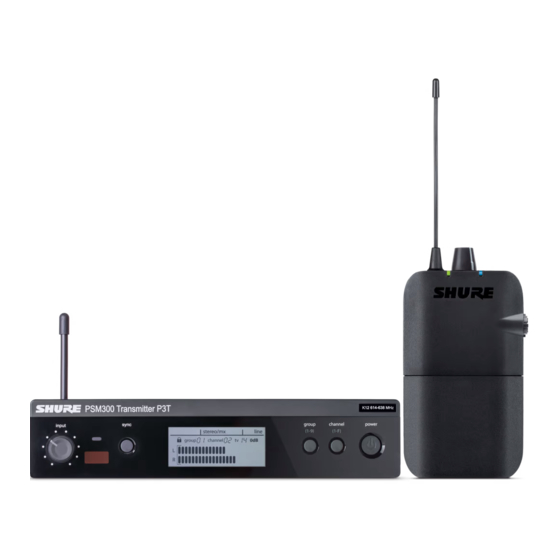
Shure PSM 300 User Manual
Stereo wireless personal monitoring system
Hide thumbs
Also See for PSM 300:
- User manual ,
- Online user's manual (36 pages) ,
- User manual (76 pages)
Table of Contents
Advertisement
Advertisement
Table of Contents

Summary of Contents for Shure PSM 300
-
Page 1: User Guide
STEREO WIRELESS PERSONAL MONITORING SYSTEM PSM 300 ® USER GUIDE Le Guide de l’Utilisateur Manuale d’uso Bedienungsanleitung Guia del Usuario Gebruikershandleiding Manual do Usuário Руководство пользователя © 2014 Shure Incorporated 27A23049 (rev. 1) Printed in China... -
Page 2: Important Safety Instructions
Shure strongly urges the user to contact supply cord or plug is damaged, liquid has been spilled or objects... -
Page 3: System Overview
CH 2 CH 1 CH 2 between transmitters and receivers. With rugged, dependable hardware and hard-working technology, Shure PSM300 Personal Monitor Systems deliver a greatly improved monitoring experience on stage. Features • Send two channels of audio wirelessly to performers onstage •... - Page 4 ⑦ Power Turns power on or off ⑬ BNC Antenna Connector Connect the supplied ¼ wave antenna, directional antenna, or a Shure P3AC antenna combiner P3T Transmitter Display ③ Lock Status To lock or unlock the controls, press and hold the group and channel buttons until the lock icon appears/disappears.
-
Page 5: Battery Life
P3R • Audio output from receiver: 100 dB through Shure SE112 earphones receiver. For more information, please visit Power-save mode: When there are no earphones plugged in, the receiver enters www.shure.com. - Page 6 ▇ Applications Refer to the following PSM300 system scenarios prior to installation. Understanding the configuration options before setting up helps to identify signal routing requirements and plan for future expansion. Specific information on how to set up the PSM300 system and create mixes for monitoring can be found in the "System Setup and Configuration"...
- Page 7 Using the PSM300 Combined with Other Wireless Monitoring Systems In a scenario where two performers have their own wireless monitoring systems (one Shure PSM300 system and one third-party system, for example), the PSM300 can pass the signal from the mixer on to the second monitoring system.
-
Page 8: System Setup And Configuration
The P3T Transmitter can be mounted in a standard 19-inch rack. Up to two units can be mounted in a single rack space. If using multiple P3T transmitters, the Shure PA411 Antenna Combiner system can be used to consolidate and distribute all RF and power for up to four transmitters. -
Page 9: Manual Selection
Creating a Wireless Connection Between Receivers and Transmitters (Sync) To pass audio from the transmitter to the receiver, both must be tuned to the same frequency. The easiest way to configure the system is to use the automatic sync feature. This transfers group and channel settings with a press of a button. Based on your system configuration, use one of the following processes to sync the components: Single Transmitter and Receiver The following sync procedure should be used with a setup that consists of a single transmitter... -
Page 10: Operation
▇ Operation Adjusting Gain and Listening Volume For the best audio quality, start by adjusting the levels from the mixer or audio source, and then adjust levels through the PSM300 system. This approach corresponds to the way that the audio signal flows through the system, and maximizes the signal-to-noise ratio. Before you begin: verify all signal routing and gain settings at the mixer or source prior to adjusting any levels from the PSM300 system. -
Page 11: Selecting The Mode
Creating Monitor Mixes MixMode and Stereo Monitoring The mix that performers hear on stage is usually different than the The receiver can operate in stereo or MixMode when the transmitter is set mix heard by the audience. In live sound applications, the engineer to STEREO-MX. -
Page 12: Troubleshooting
Troubleshooting Problem Solution Distorted Audio • Check the volume levels at the P3T transmitter and verify that the meter is not reaching the overload indicator • Check levels going in and out of the mixer. If audio is distorting anywhere in the signal chain, it will be distorted even if the PSM300 system is not overloading. -
Page 13: Specifications
Total Harmonic Distortion ref. ±34 kHz deviation @1 kHz Configuration <0.5% (typical) Electronically balanced Companding Impedance Patented Shure Audio Reference Companding 40 kΩ (actual) Spurious Rejection Nominal Input Level ref. 12dB SINAD switchable: +4 dBu, –10 dBV >80 dB (typical) -
Page 14: Important Product Information
Licensing of Shure wireless microphone equipment is the user’s responsibility, and licensability depends on the user’s classification and application, and on the selected frequency. Shure strongly urges the user to contact the appropriate telecommunications authority concerning proper licensing, and... -
Page 15: Frequencies For European Countries
FREQUENCIES FOR EUROPEAN COUNTRIES NOTE: This Radio equipment is intended for use in musical profes- Country Code Frequency Range sional entertainment and similar applications. This Radio apparatus Code de Pays Gamme de frequences may be capable of operating on some frequencies not authorized in Codice di paese Gamme di frequenza Código de país... - Page 16 Europe, Middle East, Africa: PT. GOSHEN SWARA INDONESIA Kompleks Harco Mangga Dua Blok L No. 35 Jakarta Pusat I.16.GSI31.00501.0211...













Need help?
Do you have a question about the PSM 300 and is the answer not in the manual?
Questions and answers